
‘A SHAHEEN’s LAST FALL’
Investigation & evidence based reconstruction of the last fall of a Pakistan Air Force jet, shot down by an Indian Air Force MiG-21 in POK on 27 February 2019
Post the Indian Air Force strike on a JeM terrorist camp in Pakistan on the 26th of February 2019, followed by the high voltage aerial skirmish the next day between the rival airforces; the widespread din — created from manufactured lies, deceit and misinformation campaign by the Pakistan Army’s infamous Inter Services Public Relations (ISPR) — to deny and cover up tactical shortcomings of the Pakistan Air Force and the shooting down of the PAF aircraft — has pro-actively blurred the truth.
The first casualty of War is always the Truth! Somewhere in between this subterfuge is a PAF pilot and an aircraft tail number — shot down in heady combat by an IAF MiG-21, before the MiG itself fell victim to an air-to-air missile fired by the PAF.
The Pakistani military establishment denies the F-16 shoot down vehemently — insisting that the only aircraft which crashed in POK that fateful day was an IAF MiG-21, the fall of which is well documented in multiple amateur video feeds — while craftily masking all the evidence of the PAF aircraft crash to serve the wider agenda of upholding the morale and invincibility of the Pakistan Air Force — the Pāk Fizāʾiyah.
While the OSINT evidence is available to sift through its worth — the first indication of a massive coverup by the Pakistani state was provided by none other than Major General Asif Ghafoor, the DG ISPR — who overwhelmed by the need to be ahead in the information war with India — inadvertently gave away the presence of the #DoosraBanda within the hour post the aerial clash. However in today’s digital age — it is literally impossible to control & wipe away information traces in toto — especially on a day when hundreds of trigger happy residents in the Pakistan Occupied Kashmir (POK) had their mobile phone cameras trained towards the skies, recording the massive presence of fighter jets and their ensuing melee.
A highly detailed study of more than 128 OSINT videos dreveals — though the Pakistan military was successfully able to impose a media and communication black down over the crash site of the PAF jet thus eliminating any proof of the debris on ground, as well as keeping the focus on the crash & capture of the Indian pilot; 3 videos — two filmed near the PAF jet crash site and one taken across the LoC from J&K — clearly record the last fall of a ‘second aircraft’ in the skies south of Kotli in POK — proof that the Indian Air Force had indeed shot down a PAF asset that day!
Prelude
At around 1020 hours on 27 Feb 19, Wing Commander Abhinandan Varthaman of the Indian Air Force crossed into Pakistan Occupied Kashmir (POK) abeam the Naoshera sector of Jammu & Kashmir (J&K) while flying a MiG-21 Bison of the 51 Squadron. Abhinandan, callsign Alpha-1, who had been scrambled from Srinagar AFB — was in hot pursuit of Pakistan Air Force F-16s which as part of ‘Operation Swift Retort’ had violated the Line of Control (LoC) and launched AMRAAM missiles against IAF Su-30MKIs a few minutes back. Abhinandan, was cautioned by the IAF fighter controller at the IACCS node about a F-16 Barrier Combat Air Patrol (BARCAP) going HOT, turning around to face him — with Alpha formation advised to go COLD and return back across the LoC. While Alpha-2, Abhinandan’s №2 turned back, Abhinandan pressed on his quest to lock on to the marauding PAF jets. He had search mode indication of at least 2 x F-16s on his Kopyo radar at 30–35 km range on course 290 degree. Wanting to make sure that he did not have any targets closer than that, Abhinandan switched over to his close combat mode on the radar and swept the area ahead of him trying to get a radar assisted lock for the R-73. While climbing passing 20,000 feet, he got a lock on tone in one of his R-73s. This indicated that the missile head had locked onto an infra-red source within its gimbal limits. Basis a positive lock by the missile, Abhinandan fired the R-73 and turned around on a northerly course, before finally settling on an eastern heading towards the LoC.

About 45–50 seconds after his R-73 launch and about 7 km inside POK, the MiG-21 was hit by an AMRAAM fired by a PAF F-16.
Abhinandan ejected from the stricken aircraft and parachuted to safety, landing 4 km away from the LoC near Horan Kotla village in POK. He was brutally attacked by civilians, before being dramatically handed over to the Pakistan Army.
His ordeal made him a focal point of the developing crisis, when in gross violation of the Geneva convention, the footage of his battered face was intentionally released on Pakistani television and social media by Pakistan Army affiliates minutes later. What was clear was that the Pakistan Armed Forces had activated the now infamous Inter-Services Public Relations (ISPR) to get the narrative under control.
Meanwhile, the Indian Air Force basis the radar picture of the aerial engagement, as well as conformation from the Indian Army on visual sighting of two aircraft crashing in POK on separate radials; announced the shooting down of a Pakistan Air Force F-16. It also acknowledged the loss of one MiG-21 over POK.
Pakistan has since then — denied the loss of any airborne asset as part of ‘Operation Swift Retort’ on 27 February 2019
#EVIDENCE №1 — The ISPR’s infamous ‘Doosra Banda’
The ISPR for all its so called resourcefulness, was overwhelmed by the pace of events after the 27 Feb aerial clash — when it inadvertently admitted to the presence of a ‘second pilot’ in custody of the Pakistan Army.
Immediately after the 27 Feb 19 clash, Major General Asif Ghafoor — the Director-General of Inter-Services Public Relations (ISPR) and chief spokesperson of Pakistan Armed Forces tweeted on the ISPR handle that two Indian jets had been shot down by the PAF in POK, with one pilot arrested by the Pak army and two still in the area.

While addressing a press conference at noon, a good hour after his first significant tweet, Maj Gen Ghafoor said that — another pilot has been arrested. “Our ground forces arrested two pilots; one of them was injured and has been shifted to CMH (Combined Military Hospital) and, God-willing, he will be taken care of,” said the army official and reiterated that “The Doosra Banda (second pilot) is with us.” Maj Gen Ghafoor also assured all that no F-16 of the PAF had been shot down, since the F-16s were ‘NOT’ used in combat in that sector at all.
Interestingly, the Pakistani PM Imran Khan — also confirmed that Pakistan had two Indian pilots in custody.
However, post that press conference, the ISPR chief informed all that the pilot in their custody in the military hospital had died.
At 6:19 PM in the evening, the last tweet on the subject from Maj Gen Ghafoor clarified that the Pak Army had just ‘one’ IAF pilot in its custody.He was Wing Commander Abhinandan Varthaman.


Admissions by Pak Army’s ISPR on 27 Feb 19-
- There was an Indian pilot in Pak Army’s custody.
- There was a second pilot captured, taken to the Pak Army Combined Military Hospital (CMH).
- The second pilot in the CMH later died.
- In evening, it was confirmed that Abhinandan was now, the only Indian pilot in Pak custody.
- No F-16 of the Pakistan Air Force was used in the aerial clash that day, so no question of any being shot down by the IAF.
The moot point to observe is that Pakistan had a ‘second pilot in custody’, who later died due to his injuries in the Pak Army CMH. When this admission was made, Abhinandan was ‘already’ with the Pak Army.
The info on the second pilot to Maj Gen Ghafoor at ISPR would have passed through the following chain of commands of the Pakistan Army -
- The Locals who would have captured the pilot
- The Pak Army unit which would have taken him into custody
- The Agency which would have transported him to the CMH
- Confirmation by CMH
- Confirmation by Pak Army HQ at Rawalpindi
The first four layers of the chain of command would have ‘physically’ seen the second pilot. So there is NO question of a second pilot being a figment of someone’s imagination.

Who was the #DoosraBanda?
The ‘second pilot’ was a Pakistan Air Force pilot — who was shot down by the Indian MiG-21. Most probably having sustained post ejection injuries or being manhandled in a similar manner to Abhinandan, he was shifted to the Pak Army CMH where he had died. It is a common practice by fighter pilots across the world to fly operational missions without any mean of outward information like name tabs, squadron patches, ranks etc., making it difficult for the locals to not recognise him as a Pakistani.
In the time between Maj Gen Ghafoor’s first and last tweet — the social media, particularly on Twitter — spiked up with a virtual war between the Indian and Pakistani sympathisers. The internet presence was spearheaded by over 20,000 fake ISPR handles and bots. There was also a dedicated campaign by ISPR and Pakistan media to showcase the travails of Wing Commander Abhinandan Varthaman in the custody of the Pakistan Army, increasing in intensity as the day progressed.
With the famed ISPR doctrine of ‘delay, confuse and deny’ in play, it was a clear attempt to shift the focus of attention away from the shooting down of a PAF aircraft.
There was a second pilot — who was also captured by Pakistan Army on 27 Feb 2019.
EVIDENCE №2 — Eyewitness Account
Now lets examine the various versions of the videos floating around on the social media of eyewitnesses around the crash sites. Some of these witnesses interviewed — claim to have seen at least three different parachutes. The following key aspects emerge from the comments of the various eyewitness. Lets analyse them for their worth-
1# There were more than one parachute in the sky — Cleary seen in the various video grabs, this indicates that more than one pilot ejected.
2# Pak civilians had apprehended Abhinandan, who tried to escape, but was caught and handed over to the Pak Army — This is documented well with a flurry of ISPR and Pak media videos and images on the social media.
3# Ostensibly, one of the witness claimed that they had apprehended an IAF sikh pilot of the IAF — In all probability, the witness has confused Abhinandan, who was wearing a skull cap under his helmet, which resembles a sikh patka at times. His burly moustache with the patka would have given the impression of him being a Sikh to the eyewitnesses on ground. The same ‘Horan baba’ provides a very interesting clue though— he says another chatri (parachute) went towards Gola — which is a town further north of Horan. What it implies is that another parachute was noticed north of the location where Abhinandan crashed
The eyewitness statements clearly established that — there was more than ONE pilot who ejected that day in POK
EVIDENCE №3 — Electromagnetic Evidence
The IAF’s Phalcon AWACS, had adequate radar pick up on the aerial engagement unfolding via its powerful airborne AESA radar. In addition, the Phalcon was able to map the large force engagement (LFE) from 20,000 to 50,000 feet, distinguishing and identifying the various PAF fighters taking part through their electromagnetic emissions (radars, navigational equipment and other active sensors) — duly picked up, processed and analysed by the powerful Electronic Intelligence (ELINT) systems. It identified F-16, JF-17 and Mirage IIIs as part of the Op Swift Retort PAF aircraft package.

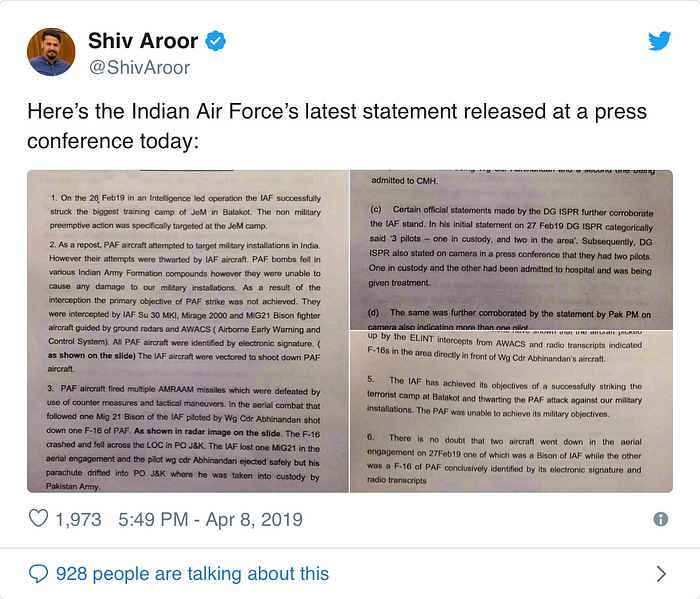
This radar data proves beyond doubt — that F-16s were operating against India that day — exposing the lies and contradictions of the DG ISPR, Maj Gen Asif Ghafoor — exposed further by the remains of the AMRAAM missile found in Naoshera sector by the Indian military. AMRAAM missiles can only be fired by F-16s in the PAF inventory.
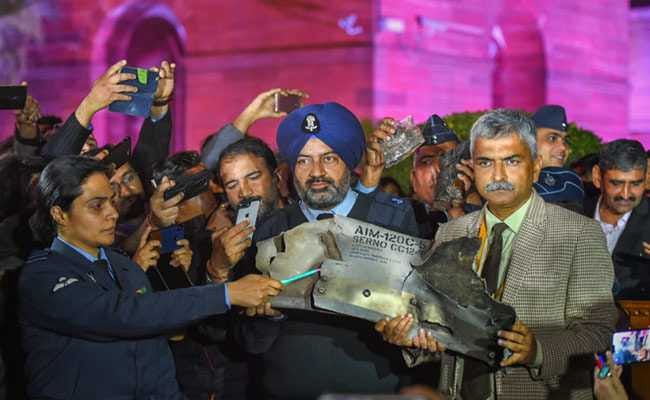
Both the IACCS ( Integrated Air Command & Control System) & The Phalcon AWACS registered the radar signature of one MiG-21 piloted by Wing Commander Abhinandan Varthaman cross the Line of Control and engage a F-16 with a R-73 missile.
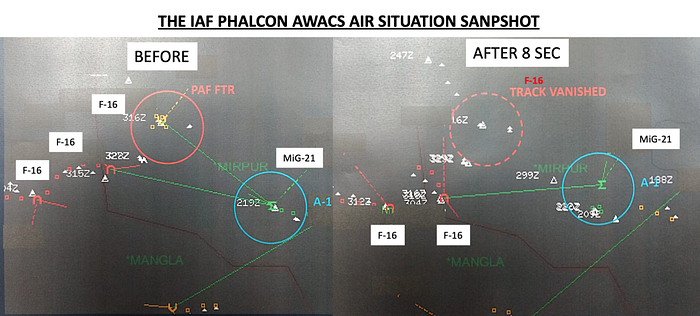
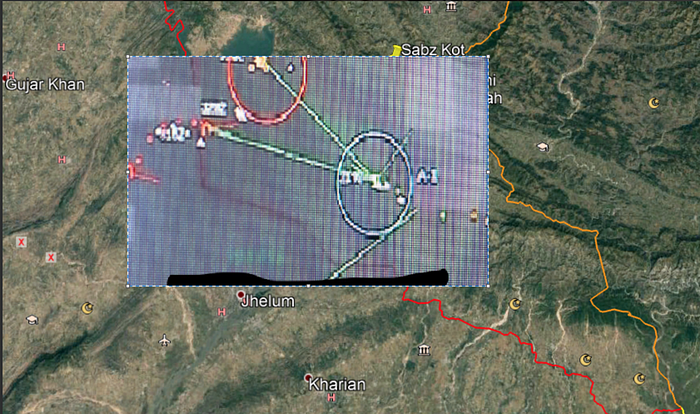
The F-16 ‘kill’ was noticed by the Phalcon’s radar — with the said blip vanishing from the radar scope in the radar picture processed 8 seconds after the previous one, which had shown the blip in place.
The same is corroborated by a Thales GS-100 Low Level Targeting Radar (LLTR) deployed in that area and integrated into the IACCS. The GS-100 is an AESA radar with low-altitude search capability that can track targets up to 180 km range with high accuracy. The post event milking out of radar data from the GS-100 clearly has shown the MiG-21 closing into the F-16s, The overlapping time and place of the missile launch and the subsequent ‘splash’ with the blip vanishing is registered very accurately, matching with the Phalcon data.
The same LLTR had clearly registered a PAF F-16 maneuvering towards Abhinandan’s MiG-21, as he turned northwards post his missile launch. Guided by the Saab ERIEYE, in a classic Type III converting into a Type IV interception by the F-16 — which fired an AMRAAM from south of Mangla reservoir to shoot down the IAF MiG-21. The LLTR noticed the MiG-21 blip vanishing after nearly a minute post the F-16 kill, matching with the account from Abhinandan’s debrief post repatriation back to India.
There is merit in arguing that a blip can vanish from the scope due pick up issues over undulating terrain and masking, or tactical manoeuvres carried by combat aircraft like cranking or notching to get into the doppler slot of a radar, as well as rapid change of height. However, with over 4–5 geographically distanced ground radars and airborne (AWACS) radars recording the disappearance of the blip, this argument does not apply.
The official comment of the Indian Air Force’s Fighter Controller, Sqn Ldr Minty Agarwal who was vectoring Abhinandan and his №2, is available here. She clearly acknowledges that the PAF blip dissapeared from her radar while viewing the ensuing air battle in the IACCS node.
This is hard evidence — based on the recorded radar signature of a PAF aircraft— indicative to be a F-16 through ELINT info, which went down in POK on that day.
EVIDENCE №4 — Visual Sighting and Radio Intercepts by Indian Army
The air battle was visible in great details, on both sides of the LoC, thanks to the contrails formed at the altitudes where the jets were operating on most occasions.
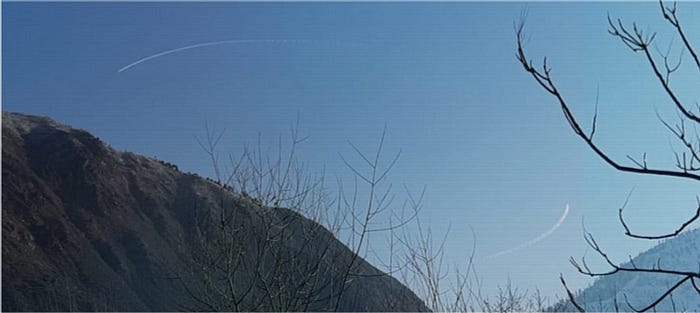
As the F-16 fell to the ground after being hit by the MiG-21, its downward trajectory with parachutes in proximity, was recorded by at least 2 different geographically apart Indian Army posts, which accurately estimated that the wreckage would have fallen 8–10 km in POK general area Sabzkot.
About 40–50 seconds later, the same army posts noticed and tracked Abhinandan’s MiG-21 going down and his ejection in general area Tandar 6–7 km in POK, which through OSINT is close to the village of Horan Kotla where the wreckage can be seen on social media.
Radio intercepts picked up by the Indian Army around 1145hours recorded Pakistani soldiers from Northern Light Infantry (NLI) talking about two ‘parinda‘ (aircraft) and two ‘parinde wale‘ (pilots), having bagged one in their custody.
While the first parachute was seen in General Area Sabzkot, the second parachute was spotted in General Area Tandar. The distance between the two locations of the F-16 and MiG-21 wreckage is about 6–7 kms.
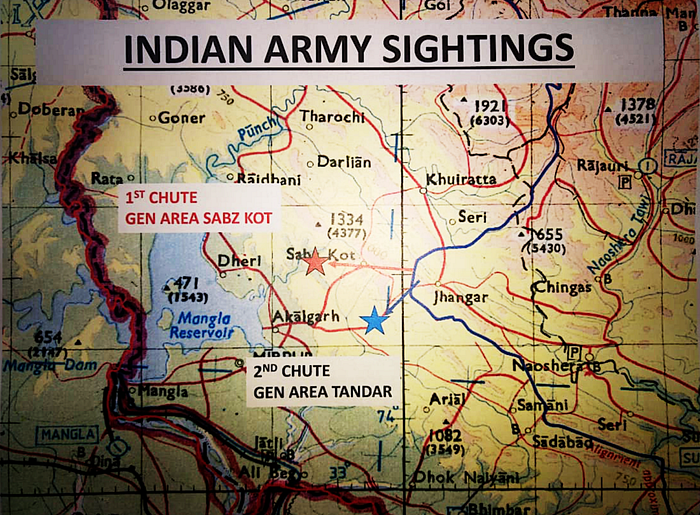
In a damning intercept at 1242H, a soldier of 7 Northern Light Infantry battalion, Tandar area, blatantly talks about soldiers from 658 Mujahid battalion having picked up a second pilot — which was Abhinandan as seen with the Mujahid soldiers in the various social media grabs. The NLI soldiers already had one pilot in custody at the time. At 1520 hours, another intercept says that while one pilot is in custody, another has been sent to the military hospital.
So if one was Abhinandan with the Mujahids, who was the second pilot with the NLI battalion?
Besides the initial eyewitness account of POK locals stating that two parachutes were spotted— the sighting by the Indian army of two parachutes coming down— proves that a second pilot also landed in POK that day
EVIDENCE №5 — ‘Evidence tampering’ by the DG ISPR
On 5 April, the DG ISPR Maj Gen Asif Ghafoor came out with a supposedly new piece of ‘evidence’ to support the claim that Abhinandan NEVER launched his R-73 missile. This happened post recovery of the MiG-21 debris from the crash site — a photo of which clearly show a burnt out R-73 on its launcher rail, with its seeker head a few feet ahead, lying near the nose of the MiG-21. Interestingly, the ‘second’ R-73 is NOT visible anywhere in the debris.

That caught Maj Gen Asif Ghafoor’s goat and he, with support from the Pak Army dirty tricks department and some resourceful ‘jugaad’ — tweeted a picture of the so called 4 air-to-air missiles recovered from the MiG-21 crash site, insinuating that — no missile was fired by the MiG-21 — with all being recovered at the site of the wreckage.

Now here in lies a story — a story of a lie, deceit and misdirection — Gen Ghafoor posted a ‘grainy’ low resolution photograph of 4 missiles — 2 x R-77 and 2 x R-73. The R-73 missile seen burnt on its launcher, is very much there with its seeker head lying loose on extreme right. But, what is a modern day miracle — is the recovery of a near intact Vympel R-73 from the crash site (shown on extreme left).
Gen Ghafoor opportunistically timed this tweet with the release of the Foreign Policy media piece by Lara Seligman, who claimed in her post that US government sources had confirmed to her that NO F-16s had been lost by the PAF. The article created a furore in Indian circles, wherein the US Government denied that any such count had taken place at all. But Gen Ghafoor was looking for one such opportunity to slip past his misdirection effort, which beyond making him the most ‘liked’ Pakistani General on twitter — unfortunately exposes his ‘evidence tampering’ lie to a great extent!
A very thoughtful tweet on the above does full justice to Maj Gen Ghafoor’s protracted effort to keep up the disinformation campaign against India -

Yes, Maj Gen Ghafoor and his ilk — picked up a R-73 from the black market or one of its allies; and tagged it as a near intact R-73 — to support that NO R-73 launch took place on that fateful day.
The ‘tampered evidence’ presented by Mister Ghafoor is exposed by these three pertinent questions—
1. Why the grainy image, especially since its of no help to a serious observer wanting to examine same for authenticity
2. Why NO observers allowed to check on these missiles — up, close and personal?
3. Why NO serial number of the recovered R-73 provided, not even a partial one?
Maj Gen Asif Ghafoor’s doctored evidence is proof that ISPR desperately wants to bury the PAF aircraft shoot down theory.
Because the ISPR boss knows that he and his army of bots, can control the narrative only so much — knowing well that in spite of the Pak Army’s best effort to cover the crashed debris of the PAF asset, the social media is a far larger and sordid entity — beyond the control of any single nation — and one day — an image of the ‘second plane’ crashing in the POK will pop out from some abyss of the very medium which the likes of him exploit to generate misinformation; to come and haunt the Pakistan Armed Forces at large.
#EXAMINING FRESH OSINT EVIDENCE: Beyond all the available hard evidence produced so far — what Pakistan laments and uses as a counter point to IAF’s PAF aircraft shoot-down claim — is the lack of any VISUAL evidence of the crashed PAF jet.
128 OSINT videos showing the air melee over POK — uploaded on various social media and OSINT sites have been painstakingly examined by a group of dedicated Indian aviation enthusiasts with the twitter handles — @bennedose @bishwa55900127 @sayareakd @anshumig and @joe_sameer. The motivation for their effort has pivoted around the fact — that the Pakistan cannot be allowed to peddle a blatant lie, change the narrative and dismember the ‘truth’ to seek glory for the Pakistan Air Force. The truth, masked behind ISPR’s disinformation campaign is that — an Indian Air Force MiG-21 on 27 Feb 19 has shot down a PAF fighter jet in Pakistan Occupied Kashmir.
And PROOF to that effect is available — in 3 amateur videos showing the — missile hit, a parachute, the crash of part debris and finally in full glory, the PAF jet’s last fall towards mother earth!
So how do we know that these videos are not fake/ tampered OR from some other part of the world?
To mitigate this, a large amount of effort beyond the deep analysis and reconstruction of the air situation — went towards cross-checking the technical authenticity of the videos (@sayareak,@bennedose, @Vakil_Raghu) and geotagging/ locations (@bishwa55900127, @bennedose ) them to their actual locations as seen on Google Earth and aircraft tactics (@anshumig). Basis this— we can very realistically re-create the events after launch of the Abhinandan’s R-73.
Mating the video info and their geolocations with routine mathematics — a crash zone with a reasonable measure of accuracy has been deduced towards the end.
The 3 videos with irrefutable proof of the fall of the PAF jet are given below. The names reflect the location near which these have been taken from —
#EVIDENCE 6: THE TADPOLE
The ‘Tadpole’ — a nickname given to a tadpole shaped ‘large smokey cloud like object’, which was observed from two locations — Charhoi and Thanamandi (ref videos). In both videos, the ‘Tadpole’ stands out against a clear sky, which is devoid of any clouds and any other natural phenomenon.
So what was is it?
Before analysing the videos, lets take a look at the position of the sun in southern POK area on 27 Feb 19 at approx 1020 — 1030 hours. The position is as shown below, obtained through a Sun position calculator and will be used for calculating the directions as required.
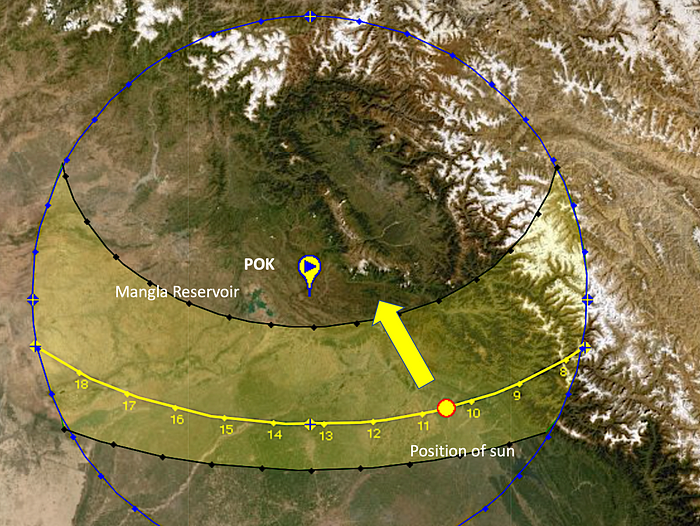
1. Analysing the Thanamandi video —
This video was shot by a Kashmiri named Wasim from the Thanamandi town of Rajouri district in J&K, looking towards POK from his location. It was uploaded on Youtube on 28 Feb 19. From the shadow of the objects and the known position of the sun at approx 1030 hours in J&K, it can be inferred that the observer is looking towards a westerly course of 230–250 degrees.
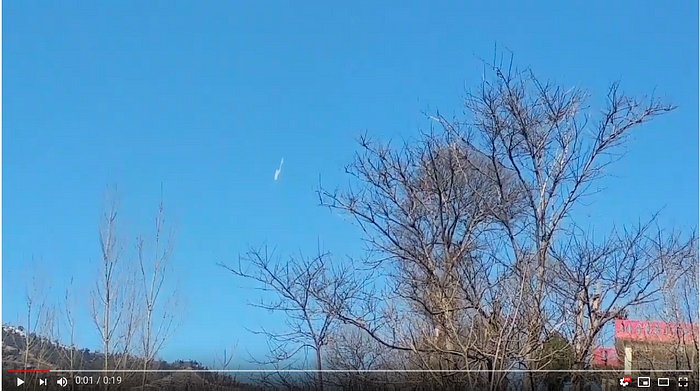
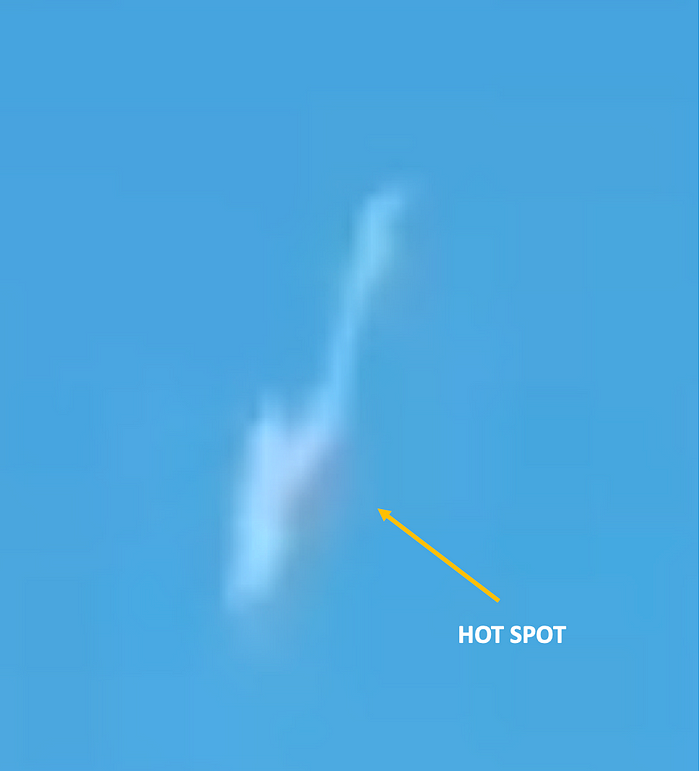
An image analysis of the enlarged view of the Tadpole indicates presence of a hot spot — with a fire burning within, shielded by the emanating smoke.
This clearly indicates that the Tadpole is a man made object on fire.
With feedback from Wasim that he had taken the video from his mobile phone from Thanamandi area in J&K, it was easy to locate and geotag the location using Google Earth. The coordinates of the observer are 33°31'30.90"N, 74°20'37.20"E at an AMSL altitude of 4,800 feet . His geotagged position with Google Earth (Courtsey @bishwa55900127) is as shown below -

The ‘Tadpole’ is mathematically calculated to be at a distance of between 37–40 km from, and 8,000 feet higher than the observer, which makes it 4,800+8,000 feet=12,800 feet or 13,000 feet AMSL. Basis this the (bottom to top) height of the Tadpole is calculated as approx. 800–1000 feet. Thanamandi to Tadpole line is from 33°31'30.90"N, 74°20'37.20"E to 33°22'14.54"N, 73°46'4.47"E, that means that the Tadpole is located anywhere on this line between 37–40 km
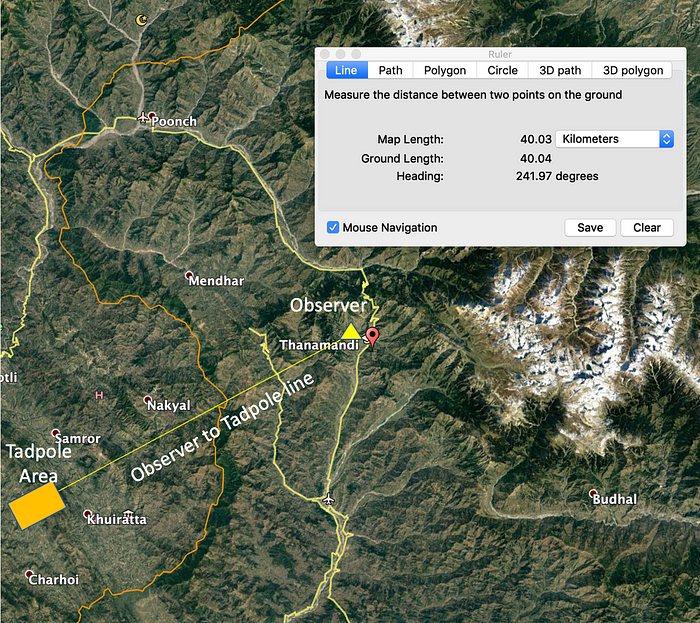
2. Analysing the Charohi video —
The Charohi video which was shot by an unknown POK resident using a mobile camera, captures some very crucial events on 27 February. These raw clips from the same mobile within the period 1020–1045 hours were stitched together and uploaded on YouTube. It shows the same Tadpole as seen in the Thanamandi video from a different direction, which assessing the position of the sun, is on a course between 020–030 from the observer.

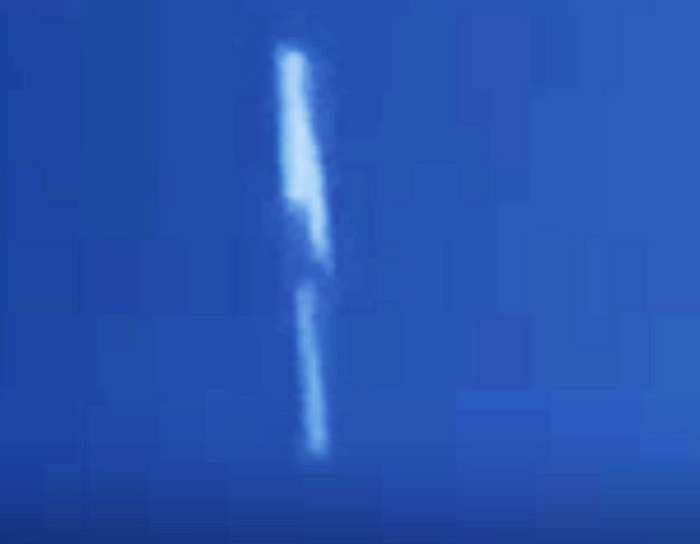
When we superimpose the Tadpole seen from Charohi with the one seen from Thanamandi, we get the SAME image. Both locations are seeing the same smokey cloud.

Geotagging and finding the location of the observer took a while since the origin was unknown. However two images in the video do provide us a clue to the location — a mobile tower and a building with a water tank, both located in the vicinity. The observer is on the building with the water tank. The scene matching with GE was done by @bennedose & @bishwa55900127, who were able to pin point the location well.



The location of Charohi building is at 33°18'29.17"N 73°57'25.38"E. Its elevation is aprox. 2900 feet AMSL. Using maths and related thumb rules, the Tadpole near Charohi was 3000–4000 feet above the observer, or 2900 + 3500 (avg)= 6500 feet AMSL. Means that the Charohi observer saw the Tadpole at a slightly later stage then as seen from Thanamandi. In fact, towards the end in the Charohi video, one can see that the Tadpole starts to marginally disintegrate.
Taking the heading of the Tadpole from the Charohi observer as 025 degree on a north-east extended line, we now bisect it with the extended line from the Thanamandi observer. This gives us a ballpark position of the Tadpole on the map.

3. Tadpole — resolving the mystery
The Thanamandi and Charohi videos cleary bring out that the burning object falling in the sky was made of combustible material. While the Thanamadi observer captured the Tadpole in a well formed state around 13,000 feet AMSL— the burning object would have needed at least 8–10,000 feet to attain that shape from a initial null position, hence from altitude around 23–25,000 feet AMSL. The white smoke and cloudy appearance also indicates — very high temperatures and continuous combustion from a supportive material, as well as condensation due low temperatures of the burning fuel.
So what would have the capacity to burn continuously, condense, as well as fall at a low ROD giving an appearance of a tadpole like cloud?
Fuel!
Yes, lots of fuel. Okay, this would have to be a very cold day that warms up dramatically initially and then sustains very gradual warming, leading to condensation of fuel which burns steady and slowly thereafter. But when does this ever happen?
On an average, the temperature drops by 2 degrees Celsius for every 1,000 feet of altitude gained, which would mean a drop of 2 x 22,000 feet (elevation allowance of 3,000 feet)= 44 degree change. With the ground temperature over POK on 27 Feb around 1020hours being in the region of 10 degree centigrade, at 25,000 feet AMSL works out to be +10–44 = — 33 degrees centrigade. And what would cause sudden, very high rise temperature spike enough to ignite fuel at -33 degree centigrade?
That would be a combustible material — which will burn very fast, producing very high temperatures, as well as adjust to temperture changes quickly. Aluminum, is second only to copper for rapid heat transfer properties, which will burn at a very fast rate, within a confined zone.
And once the combustible material burns out, the large volume of condensation of fuel, would still be good enough to maintain the consistency and cloudy shape of the tadpole, dissipating gradually.
Here’s the 75 million dollar question — What is made of aluminium and carries a lot of fuel in the sky?
A fighter jet !!
For trivia’s sake, 80 percent of the airframe structure of the F-16 is of conventional aluminum alloy.
The Tadpole was formed after an aircraft’s aluminium airframe caught fire due to volatile kinetic stress — the damage releasing huge quantities of fuel in the rarified cold air, experiencing condensation and started burning at a slow, but steady rate. A gallon of Jet A-1 type fuel weighs 6.66 pounds, which in its condensed form would have a low rate of decent — the net result — white smoke due to very high temperature (in addition to the aluminium airframe and fuel, all the armament would have exploded) intermixed with condensed fuel falling towards earth very slowly, forming a near definitive cloud like shape till dissipation at lower (warmer) levels. On that day, temperatures till about 4–5000 feet AGL would have been below freezing point, hence seen for a large duration of time from two different locations. Would probably have started to dissipate below 5000 feet AGL , especially with the airframe having burnt out much earlier, encountering warmer temperatures below the freezing point during descent.

Refer the Thanamandi image on the left — the hot spot nearly encompasses an area of 150 feet (height) x 75 feet (width), which indicates a super HOT core. In the Charohi image (right) there is no hot spot, which indicates the combustion material may have completely burnt out. There would however be very small pieces of unburnt debris and molten metal, which would have fallen below the Tadpole over a large area.
A very critical output here is that — MOST of the airframe would have burnt out at a very fast rate , hence no large sized debris in that zone.
The Tadpole— is the VISUAL PROOF of the crash of a second aircraft in POK on 27 February 2019!
IF IAF only lost one aircraft — who lost a second aircraft that day?
(Why the Tadpole cannot be the IAF MiG-21 is addressed in subsequent paragraphs. Also the claimed Su-30MKI kill by the PAF was supposed to have fallen over J&K, not POK)
I can close the argument right here — because we now have the VISUAL proof of a ‘PAF asset’ going down during Op Swift Retort!
Yes, there is no image of the debris on ground (neither will there be anything meaningful)— but since time immortal, kills have been granted basis gun camera footage — in absence of which, the crashing image of the ‘Tadpole’ is a very serious piece of evidence — debunking consistent lies of the PAF and ISPR on the subject.
However, let's continue the reconstruction of events to get to the bottom of what happened that day! So what caused a PAF fighter jet to convert into a Tadpole?
It all started with a Puff!
#EVIDENCE 7: THE PUFF
The ‘Puff’ was the point of impact of a R-73 missile with the PAF aircraft. It can be seen in two videos in different capacities, setting in motion a series of events, which culminated in the formation of the tadpole.
1. The Puff: Analysing the Charohi video —
The Charohi video interestingly starts with a missile streak and appearance of a small ‘puff’ of smoke after some seconds, followed by sound of twin thuds at an estimated distance of 4–5 km from the observer.
Based on the sun position that day, the observer is looking at this on a heading between 290–320 degrees. The visible missile streak is indicative of an air-air-missile, with the puff being its point of impact.



Could it have been a contrail? Possible at higher levels as seen that day — but unlikely around 25,000 feet for a small missile.
The puff appears 4–5 seconds after the spotting of the streak in the video, followed by two sharp thuds. Is this the MiG-21 shootdown video?
No, NOT the MiG-21 being hit by an AMRAAM (the MiG-21 crash videos is available here and here as reference). The MiG after being hit, fell down fast, with a well formed smoke trail and one loud sharp bang — While in the Charohi video, no other event is noticeable around the ‘puff’ for a considerable period thereafter.
The major difference being that — the ‘puff’ indicates an explosion of a warhead which has NOT caused any upfront incendiary damage — On the other hand, a large smoke trail in the MiG video is indicative of a post impact explosion and trauma.
Also the twin thuds heard in the Charohi video, indicate the explosion of the missile warhead and probable deceleration below Mach 1 barrier by the stricken aircraft (wherein as per IACCS radar info, most PAF BARCAP F-16’s were flying supersonic over Mach 1+)

In terms of directions, for the observer at Charohi — the MiG-21 crash site is on a southerly course of 170 degrees or so, while the ‘puff’ is on approx. direction of 300 degrees.
Hence the missile streak and the ‘puff’ in the Charohi video are not related to the MiG-21 crash at all.
The ‘Puff’ as seen in the video is the point where the proximity fuse of the R-73 has activated its warhead close to a PAF aircraft (not visible)
Skeptics will question why cannot this be an AMRAAM fired from a PAF jet? To the best my knowledge, no PAF missile was fired in this direction. On the other hand, the R-73 launch and distance covered by the missile matches perfectly with Abhi’s initial position as per the IACCS radar picture provided in Evidence No3. More on this later

What happened after the ‘Puff’?
#EVIDENCE 8: THE PUFF, A PARACHUTE & A PIECE OF DEBRIS
The journey of the PAF aircraft after being hit by the R-73 is captured in the №3 video called Khuiratta, available here.
Captured by an amateur who would have reacted at least 10 seconds after hearing the twin thuds post the ‘puff’ event and spotting the scene unfolding — is taken near the town of Khuiratta in POK. The observer is capturing the aerial component of the video on looking on course 220–250 degrees, which confirms with the angle of the sun at that time.
This video provides the chain of events between the ‘Puff’ and the ‘Tadpole’ — capturing the impact point ‘puff’ (which appears momentarily at 1:14 in the video) and post that, details the fall of a debris from the PAF aircraft and a parachute coming down.
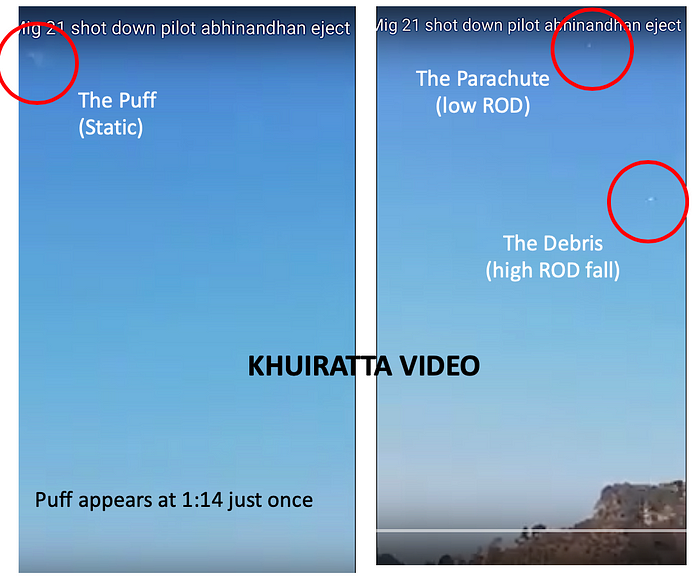
If we take a close up look and compare the puff seen in the Khuiratta video, we see that its the same event seen in the Charohi video.

The geotagging and Google Earth scene matching of the observer’s position was done by @bishwa55900127, which is shown as below.
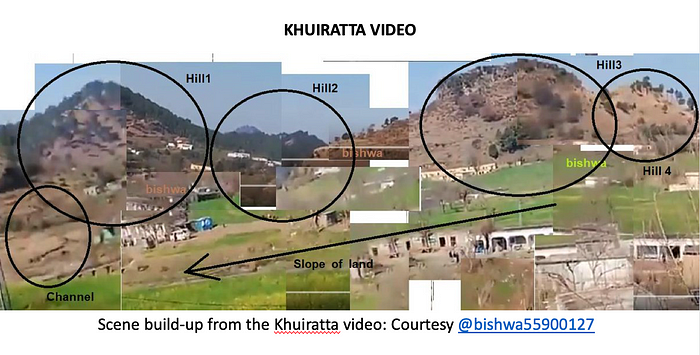


The location of the Khuiratta observer is at 33°14'13.82"N, 73° 54'25.29"E
Next we calculate the distance to the various objects seen in the seen and their direction lines. Here @bishwa55900127 has done the math well -

The montage of linked images show the complete scene in the video. The highest entity seen in the video is the ‘puff’, which may be around 25,000 feet AMSL. Mostly we see a parachute and a partial debris falling towards the earth. What is interesting to note is that these (puff-parachute-debris) appear to be on a near line.
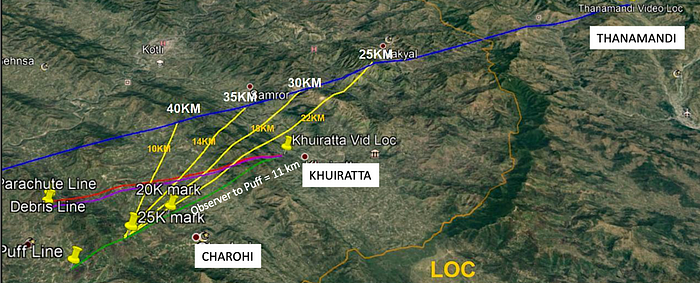
Puff line : 33°22'9.96"N, 74° 0'23.89"E to 33°17'27.90"N, 73°52'47.01"E Debris line : 33°22'9.96"N, 74° 0'23.89"E to 33°20'32.56"N, 73°51'4.00"E Parachute line: 33°22'9.96"N, 74° 0'23.89"E to 33°20'15.53"N, 73°51'10.37"E
The distance of the puff from the observer is around 11 km (with the aircraft at 25,000 feet AMSL). The debris falling is a piece of the aircraft and NOT the complete aircraft.
The various inferences are —
- The ‘Puff’ or a missile impact is clearly seen from 2 differnt locations. In the Khuiratta video we have assumed that the observer starts to record 10 seconds after hearing the twin thuds from the R-73 explosion.
- In the video — we see a low rate of descent object falling — which can only be a parachute.
- There is a displaced gap between the ‘puff’ and the parachute and the debris. The approx. distance between them is calculated as 6 km. It also indicates that the pilot ejected after a ‘delay’ post the initial impact at the ‘puff’.
- The debris falling with a high rate of descent in this video is a ‘partial’ debris piece from the aircraft, having detached from the aircraft. This debris, will be the largest part of the aircraft still intact, especially in light of the fact that most of the airframe would have burnt during the Tadpole formation in the next phase— being seen to fall from the sky without any major fire.
- We still cannot see the aircraft in the video.
Why can’t this be the MiG-21 crashing?
It is not — because both aircraft crashes, are TWO distinct and DIFFERENT shoot-downs — each exhibiting a characteristic conveying the manner in which they were shot down.


The Khuiratta video shows the parachute of a PAF fighter pilot, as well as a part of the debris falling after the ‘puff’ event — cementing the fact that there indeed is a ‘Doosra Banda’ in this very intriguing episode.
It also gives us a clue that in all probability, the PAF aircraft which crashed was a single seater, unless for some reason in a twin seater — the other pilot was not able to eject out.
Combining the Observation Lines — The ‘Puff’, Parachute, Debris and the Tadpole — From all 3 Videos

The combination of the observation lines from all three videos from the Puff to Tadpole formation stage, will help us zero down on the approximate landing zones of the PAF parachute, the falling piece of debris, as well as the Tadpole formation zone.
What we don’t have is the at what altitude was the PAF jet, when it was hit? Also, what was its speed and related parameters. A combination of these inputs, will give us near accurate points on the observation lines as shown above. This would help resolve the investigation to the subject in the most logical manner.
For this, we will need to go back to the time — when Abhinandan crossed over into Pakistan Occupied Kashmir around 1020 hours, 27 Feb 2019.
‘MiG-21 vs F-16’
Reconstructing the AIR COMBAT ENGAGEMENT OVER POK between 1020 to 1045 hours
Wing Commander Abhinandan Varthaman crossed over to POK sometime after 1020 hours, flying at 0.9 Mach at an altitude of 15,000 feet. He spotted targets on his Kopyo radar in search mode at 30–35 km, higher at 30–35,000 feet. He switctched to close combat (CC) mode on course 290 (deg) and sweeped (cover a specified Field of View from the nose) the area ahead to pick anything closer. He was climbing. His approximate position is as shown in the radar picture shared by the Indian Air Force.

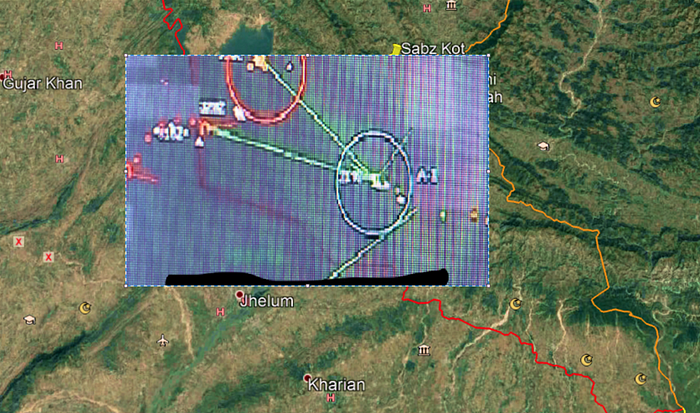
Abhinandan was callsign ‘Alpha-1’. At this stage his No2 (Alpha-2) had turned back and was back in Indian territory.
Co-incidentally, the PAF Barrier Combat Air Patrol (BARCAP) at that time, may also have had the call sign ‘Alpha’. Tens of minutes before that 2 x 4 aircraft F-16 formations (total 8 aircraft) of 9 Sqn (Griffins) and 29 Sqn- CCS (Agressors), both from Sargodha AFB had performed Offensive Counter Air (OCA) Missions at the LoC, where they had fired 4–5 AIM-120C-5 missiles against IAF Su-30MKIs, claiming a Su-30MKI kill. Two formations (C/S Bravo & Charlie) had fallen back around 1017 hours and the third (Alpha) now formed the BARCAP in depth. These were controlled by a Saab ERIEYE AEW&C aircraft, Callsign — ‘Vigil’. Alpha 1–4 (all probably from 29 Sqn-CCS) were the 4 x F-16s which the IAF radar picture showed.
As per sources in the IAF, the call sign of the aircraft which went down in POK that day was ‘Alpha-3’. This is per PAF’s R/T intercept, wherein after this sharp engagement, Callsign Alpha-3, never responded back on any communication channel.
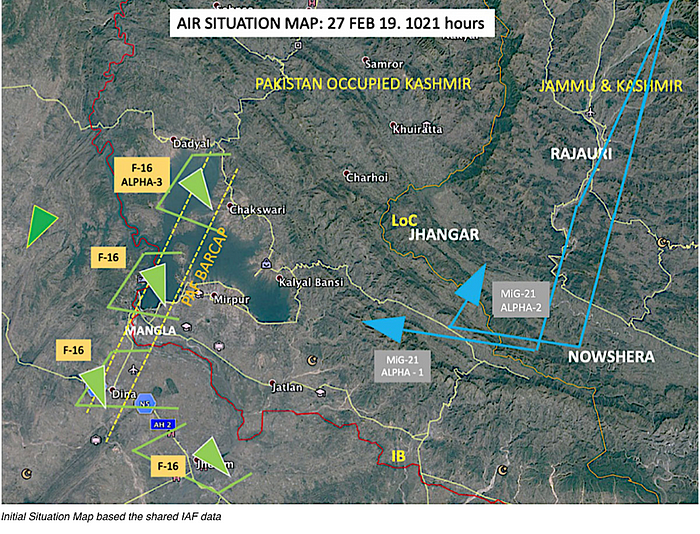
As Abhinandan was looking for targets in in CC mode, he got a missile seeker head lock. Important to note, it was not a radar assisted Lock, but a missile head Lock — which picked up a heat emitting target out to 30 km within its 30 deg field of view.
Abhinandan fired his missile while course on course 280 at 20,000 feet, turning northwards and finally settling down on a eastern heading towards Jhangar in J&K for a getaway.
So what really happened that day?
The subsequent sequence of events give a ‘blow by blow’ account of the final aerial engagement till the last fall of a PAF jet in POK.
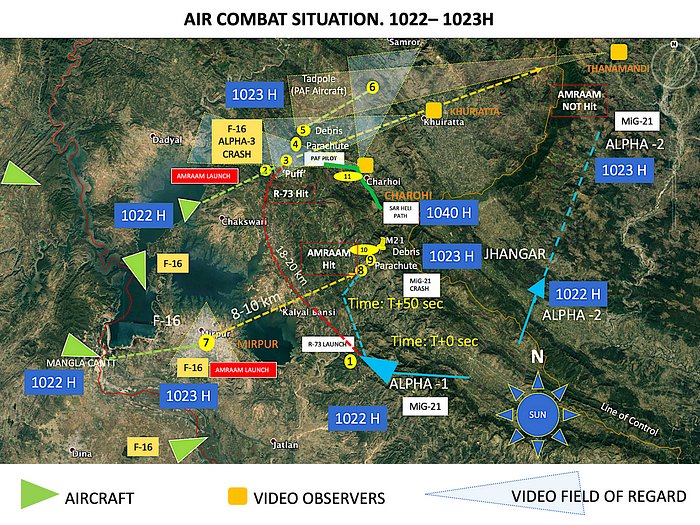
Refer the above consolidated air situation map for events taking place, sequentially marked from 1 to 10 from 1020 to 1040 hours in the following paragraphs.
Event №1 1022H — Launch of an IAF R-73 AAM against a PAF F-16
- Abhinandan launched a R-73 missile on an heading of 280–290 degrees at 20,000 feet after the missile head locked onto a target in frontal quarters. Since the radar was in close combat (CC)search mode at that time, the aircraft being tracked by the R-73 would not have got any Lock ON chirp on its radar warning receiver (RWR). Neither does the R-73 missile give any approach warning while using passive guidance.
The PAF aircraft, targeted by the IAF MiG-21, was NOT aware that a R-73 missile had been fired against it.
2. The R-73 seeker could have locked on to 2 PAF jets, one at north edge and the other at the bottom edge of the Mangla reservoir. The blip at the north edge, which subsequently vanished from the scope was flying at Mach 1+ at 32,000 feet.

The IAF’s ELINT data suggests that an F-16 was on the bearing where PAF’s Alpha-3 was noticed — hence in all probility, the blip which vanished was a F-16.
3. This F-16 was identified to have a the callsign — ‘Alpha-3’ (IAF radio intercept)
Event №2 1022H — PAF targeting Abhi’s №2
- The PAF’s F-16, north over the Mangla reservoir, Call sign Alpha -3 was vectored eastwards to intercept Abhinandan’s №2, who by now was back across the LoC in J&K, heading north east in Rajouri sector.
- As per reconstruction of the sit, the F-16 (Alpha-3) was at 32,000 feet and assisted by ‘Vigil’ (AEW&C) picked up the MiG-21 (Abhi’s №2) on his airborne interception (AI) radar at 60–70 km at 18,000 feet. The F-16 did a fast descending turn to a lower altitude to build up speed and achieve his firing solution sooner, as well as carrying out a rapid change of height to break any fire control lock with all aware that MiGs had crossed the LoC. For info, at Mach 1.5 the AIM-120C-5 AMRAAM receives a bump up of 10–15% in max range (standard USAF AMRAAM firing tactics).
- He would have fired his AMRAAM at IAF’s ALpha-2 between Dmax 1- 2. This missile is seen in the Thanamandi video. We can also hear the sound of the Indian MiG-21, indicating it was close.

We know for sure now that the PAF fired an AMRAAM on Abhi’s №2. The AMRAAM missed Abhinandan’s №2, who had gone COLD by then.
Event №3 1023 hours — The ‘Puff’
- This describes the ‘puff’ point, when the R-73 missile fired by the MiG-21 reached the vicinity of the F-16 and activated its proximity fuse. The ‘puff’ happened at the crossection of the observer to the ‘puff’ lines from Khuiratta and Charohi.

5. From Abhi’s last plotted position to the calculated position of the ‘puff’ is a distance of 20 km. The R-73 would have covered this distance + distance required during the proportional navigation ‘lead pursuit’ trajectory. Assuming max 2–3 km deviation for this trajectory from point to point navigation with a non maneuvering, supersonic speed F-16 in the R-73’s frontal quarters, passing left to right and descending. So the R-73 covered approx. 22 km to the ‘puff’ location. The F-16’s trajectory actually benefits the R-73 in adjusting a steady (greater) lead ahead and bleeds lesser energy. Reverse calculating we get time of flight of R-73 to ‘puff’ location at an average speed of 612 m/s at 35 seconds.

6. Flying at Mach 1 (conservative estimate), descending from 32,000 to 25,000 feet, the F-16 would have covered a ground distance of around 375 meters every second (subsonic to supersonic at an average altitude of 28,000 feet at -39 to 40 deg centigrade for that day). Assuming it turned for 3-5 seconds before it proceeded for the intercept (IAF radar picture showed this F-16 in a slight descending turn to left and assuming 20 deg/ sec rate of turn), in 35–5 = 30 seconds — it would cover 11250m or 11.25 km — which is close to the estimated distance of 12 km from the F-16s initial position north of Mangla reservoir to the ‘puff’.
7. A R-73 missile can intercept a 12G manoeuvring target at 0.3–30 km. The F-16 was placed around 22 km (trajectory inclusive) from the missile.
The F-16 was well within the kinematic performance range available to the R-73 missile to shoot down the F-16.
8. How are we sure that it was this aircraft which fired the AMRAAM at Abhi’s №2 across the LoC? We are sure because — we observe only 2 missiles fired by the PAF inside POK that day. This was the first event, the second was fired to shoot down Abhinandan seconds later from south of Mangla reservoir and Mirpur town.
9. So why no explosion at the ‘puff’? For this we need to understand that the R-73 would have exploded at a near beam (3 o Clock) aspect to the F-16 based on our investigation. In my earlier assessment of Apr 19, I had assumed that the missile hit the F-16 in its frontal quarters. However I did not have the IAF radar picture and the newer video evidence. The R-73’s proximity fuse activating the 7.4 kg continous rod warhead in that aspect.

#Let’s understand how the R-73 warhead would have exploded — The R-73 has a continuous rod warhead weighing 7.4 kg — which is activated by a proximity fuse when it senses an aircraft in close quarters. When detonated, the high explosive imparts momentum to the rods, thrusting them outward in an expanding circle. The pressure wave from the explosive acts evenly on the rods over their length. The rods are sufficiently soft to allow the expansion without breaking the rods or the welded joints, and the detonation velocity is limited to approx. 1000 m/s, allowing the rods to bend at these locations instead. At some intermediate point the ring will have a zig-zag (alternating direction) appearance within a cylindrical envelope — Upon ultimate expansion the ring is circular and contained within a plane.
#This rapidly expanding ring, when hitting the aircraft, is more effective than an equivalent fragmentation warhead — for the science inclined, the ring’s effectiveness decreasing as 1/R, rather than 1/R2 for fragments.
#Portions of the aircraft intercepted by the expanding ring of the continuous rod warhead — will receive a continuous cut through the skin, light structure, underlying cables, hydraulic lines, and other plumbing if present — This may cause a structural failure, or, if not, can be sufficient for defeating the redundancy of aircraft systems. The effect is only pronounced as long as the ring is unbroken, so multiple layers of rods are employed in practical weapons to increase the effective radius.

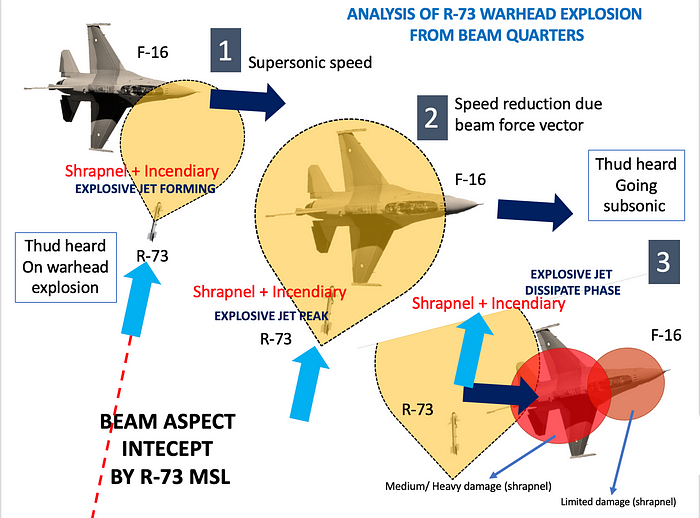
10. Basis above, we identify two zones of damage on the F-16. Travelling at a supersonic speed, the nose and the cockpit area of the F-16 would have sustained limited damage due shrapnel. This may however be enough to critically injure the pilot/s. The brunt of the continous rod warhead would have been borne by the middle to rear portion. What the ‘puff’ indicates is that the damage was mostly due to the shrapnel’s kinetic effect, not a violent incendiary explosion of any manner. The supersonic state of the aircraft is the most probable reason for the F-16 to not catch fire due to the expanding ring of the warhead.
#Continuous rod warheads generally tend to induce damage, which can slice open an aircraft as can be seen in the case of Abhinandan’s MiG-21, which was hit from the rear. So while no explosion is visible, there would have been internal damage in the rear portion, as well as a new direction vector — mix of aircraft forward speed and the impact from the right due to the warhead explosion, would have veered the damaged aircraft to the left.
11. So what was the damage on the aircraft post the hit at the ‘puff’ stage. For this, we get a very brief idea in the Charohi video. After the puff, the videographer briefly records the state of another ‘puff’ like object, which is however moving towards the right, which is identified by the effort of the person to maintain this smoke blob in the centre of the field of view of the phone. We know that this is not the puff, because the sun position for this is different. Interestingly in a short glimpse around 21 second run of the video, we see this object dividing itself in two parts.
# This object which divides itself later on into two segments, is the elusive aircraft — which has moved on from the ‘puff’ position when captured by the observer on his phone.

The R-73 hit the F-16 at supersonic speeds around 25,000 feet at the ‘puff’ location. After which it veers to leftas a resultant, and a few seconds later broke into 2 distinct parts due to damage by the R-73 warhead
Event №4 1023 hours — The ‘Parachute’
- In the Khuiratta video, we see a distinct object with a low rate of descent. While we are unable to identify the same adequately from the close up, the rate of descent indicates that this is a parachute.

2. So after the ‘puff’ event at 25,000 feet, the aircraft’s direction veered to the left on an north westerly course, which was the resultant direction of its initial supersonic speed & the impact of the R-73 warhead from the right.
# Lets assume at the point of impact at the ‘puff’ location, the speed of the aircraft was Mach 1 (375 m/s). Post impact by the R-73 with a velocity of at least 500m/s — the resultant velocity in the left turn would is approx 250 m/s for same AUW. This is effectively 990 kmph or 535 knots.
3. Now we notice, that from the ‘puff’ to the parachute/ debris, the altitude of the aircraft hasn’t changed more than 1000 odd feet. This indicates that the engine was partially still processing power output.

4, The puff to the tadpole distance shown on the 25,000 feet AMSL line in the above image is about 10 km. So the aircraft, from the puff point, travelled 10 km before converting into the tadpole shape. At what average speed will the aircraft be able to cover 10 km from the puff point?
#The average speed = 650 kmph, achieved by partial engine run till at least 35–50 sec after impact at the ‘puff’ point.
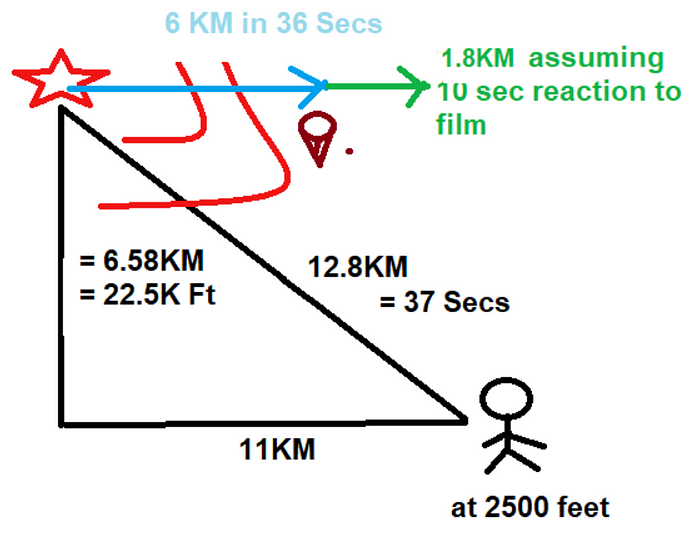
5. The F-16 was at 25,000 feet AMSL. From the observer at Khuiratta, the puff will be at a ground distance of 11 km.
6. Since the video grapher reacted basis the twin claps at the puff to film the scene, we take a 10 sec reaction time. Sound travels from puff to Khuiratta in 37 seconds. So he would have filmed at 37 + 10 seconds = 47 seconds. when he stated filming, 47 seconds had elapsed since the ‘puff’, the parachute deployed and the debris falling. In those 47 seconds, the aircraft would have travelled 8.4 km. In 37 seconds the the aircrfat would have covered approx 6 km.
7. The parachute position will be 6 km from the Khuiratta observer to the puff line, on 25,000 feet puff to Tadpole line.
8. Deploying all seen elements on the 25k line from the puff, we get approx. positions pf all objects seen in the air that day.

9. At 6 km from the puff the pilot of the F-16 ejected out of the stricken aircraft either before or after the separation of the debris, a good 36 seconds post the missile impact. What we analysed a bit back becomes relevant now, with the separation of the debris from the main aircraft body around 5-6 km from the puff, about the time the pilot ejected out. This is also the time where I believe the partial working engine would have stopped. After this the aircraft would have coasted another 4 odd km, before becoming the tadpole.

10. Back to the parachute. The ROD of the parachute is lower than the debris, but cannot be calculated due not enough frames available on the parachute, the observer focussing on the falling debris.
11. So why did the pilot delay the ejection till 36 odd seconds after the missile hit? The most plausible answer is either the pilot was injured in the missile strike or was still assessing the state of the aircraft with engine running partially, though with the aircraft breaking in at least 2 pieces after 36 seconds, the pilot would have got signs inside the cockpit a good 15–20 seconds before. Hence the latter may not be plausible.
A delayed ejection by the PAF pilot indicates that the pilot may have been stunned and injured in the R-73 hit.
12. The approximate location of the landed pilot after ejection would be on the Khuiratta — parachute line, which is displaced by 6 km from the ‘Puff’ to parachute line.
14. After landing it is highly possible that the pilot was either mobbed by POK residents or would have been in an unconscious state due injuries sustained.
15. It is quiet possible he would have been mistaken for an IAF pilot due the following reasons -
# The PAF’s F-16 ACES ejection seat resembles an Indian flag with its colours
# Most probably, there would be no outward indication on his flying coverall of any PAF affiliation. The fact that IAF and PAF belong to same sub continental stock, would have made any meaningful resemblance easier for a case of mistaken identity..
#The larger piece of the aircraft had landed a good 4–5 km from the pilot’s position, hence there was no mean to know by the smaller debris that it was a PAF jet.
The Doora Banda mentioned by DG ISPR had landed north west of Charohi around 1025H on 27 feb 19. Information clamp down was enforced in the area by Pakistan immediately after the crash, hence no close up video is available of the Parachute and the debris landing on ground.
Event №5 1023 hours — The ‘Debris’
The debris was a smaller part of the aircraft, most probably its tail portion, given that the R-73 would have inflicted most of the damage in the middle — rear section of the F-16.
- It was spotted by the Khuiratta observer falling at a high ROD. Its rate of descent has been calculated at 180 m/s
- The piece of debris would have fallen on the Khuiratta to Debris line and would be 6–7 km from the Puff to Debris line (25k line).
- That there is no news ever heard on the debris indicates that the Pak Army was able to quickly move in and clamp down on the evidence.

The large debris chunk, which fell along with the parachute, may be the only worthwhile evidence of the F-16 aircraft lost by the PAF that day
Event №6 1024 to 1028 hours — The Tadpole
Tadpole was formed a further 4 km ahead of the Parachute/ Debris line, the momentum of the aircraft taking it beyond, until, post the debris separation the aircraft, the remaining airframe finally caught fire, with thousands of gallons of fuel converting into millions of permeable and condensed droplets, taking a smokey cloud like appearance, resembling a tadpole. The formation and end has been explained in the para Evidences section.
- The Tadpole was seen in decent fidelity from the Charohi and Thanamandi videos.
- It is proven beyond doubt to be a man made object.
- Behind the smokey cloud of high temperature and fuel, the main airframe caught fire and burnt to a great extent.
- The only debris left from the airframe would be smaller sized unburnt articles and semi-molten/ molten pieces, which probably would have rained down below the overhang of the Tadpole.
- The smaller pieces of debris would have ensured that no one would be wiser to the fact that a PAF asset had been shot down. This was one of the major reason why the Pak Army was able to ensure a complete black out of information in the Kotli and Charohi zones. However, the leftover/ critical pieces of debris may have been collected over a period of time.

Is it a co-incidence that the Pak Army issued advisory in the Kotli area immediately post the tadpole crash — about use of across LoC rockets by the Indian Army?
# It was claimed that the Pak Army destroyed a couple of Indian Rockets in air. This would be the perfect alibi to cover up for the far strewn small debris/ molten elements from the crash of the PAF jet.

Tadpole — is the most conclusive VISUAL proof of the crash of a PAF jet in POK that day.
Event №7 1022 hours — The AMRAAM launch towards the MiG-21
This event is characterised by a large scale tactical failure by the PAF BARCAP, which allowed the IAF MiG-21 to penetrate 10 odd km into POK, before any tactical action was taken against him.
The AMRAAM was fired by Wing Commander Noman Ali Khan of 29 Sqn, embedded with the Combat Commander’s School (CCS) at Sargodha. Noman reached south of Mirpur, with a steady AI Lock on his APG-68 V9 radar, launching at least one AMRAAM against Wing Commander Abhinandan’s aircraft. A video link to the AMRAAM fired by him against Abhinandan on an approximate course is available here.


Fired from an altitude of 30,000 feet the AMRAAM covered the 20 odd km within its NEZ quickly and hit the IAF MiG-21 in the rear. Abhinandan ejected out successfully.
The IAF MiG-21 was shot down by a PAF AMRAAM and not a surface to air missile
Event №8,9,10 1023–1034 hours — The crash of the IAF MiG-21
50 seconds after Abhinandan Varthaman fired a R-73 against a PAF jet, he was hit by an AMRAAM. the MiG-21 crash is very well documented.
Event 8 indicates the missile hit point.

Event 9 indicates the Parachute landing point near Horan Kotla village. Event 10 indicates the area where the unburnt debris fell down.

Abhinandan, post ejection had a harrowing escape, when he was manhandled severely by an irate mob, saved by the arrival of the Pakistan Army in the nick of time. And yes, my Pakistani readers, the cup of tea is appreciated and will indeed be reciprocated!
He was made a pawn in a heightened disinformation war with India by the ISPR and after some deft diplomacy by the Indian Government, was repatriated back after 3 days in Pak custody.
Event № 11 1040H — A Pakistan Army Search & Rescue (SAR)Helicopter
The last piece of the puzzle which supports that a PAF jet was shot down on 27 Feb, is provided by an innocuous looking Pakistan Army light communication helicopter, a Bell Jet Ranger. Utilised routinely for communication duties, the helicopter would not have caught our eye, except that it is featured in the Charohi video flying at ultra low level, after the Tadpole event.
After plotting its path, we see it make a left turn in front of the Charohi videographer, heading for….surprise, surprise…the location of the downed PAF pilot’s parchute landing zone.

A major aerial engagement had taken just a few minutes back, with the perpetual loss of situational awareness (LOSA) still hanging over the battlefield — here what business did a Pak Army communication/ SAR helicopter have flying around without a highly urgent task at hand?
Or maybe the heli did have an urgent task!


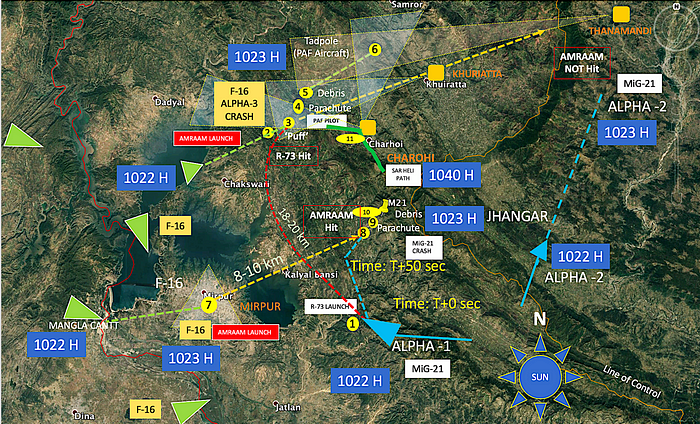
The Bell Jet Ranger, was airborne minutes after the aerial engagement to locate and pick up the the crashed PAF pilot.
Analysing the Fog of war
Yes, there would have been solid confusion in POK from 1020 hours to 1100 hours. In air, the PAF would have been surprised by the dash of the MiG-21, more after the PAF aircraft went missing. I am informed that a loss of situational awareness (LOSA) happened as soon as an R/T check was done after shooting down the MiG-21. In fact, it is highly probable that the Tadpole may have been seen visually by other members of the Alpha formation, realising for the first time that another jet has gone down. This is reinforced by the fact that we can hear aircraft sound over the tadpole in the Charhoi video. The PAF knew they had lost an asset within minutes of its loss.
On ground it may have been even more chaotic. Abhinandan fell, with his aircraft in close vicinity, so was easily tagged and captured. But with the parachute and debris landing north west of Charohi, and the Tadpole still in the air — would have given an impression to the Pak Army on ground that — two more aircraft had been shot down. This may indeed be the origin of the legend of the Doosra Banda.
- Abhinandan is captured by Pak Army near Horran Kotla — Maj Gen Ghafoor confirms.
- One parachute lands north west of Charohi — Maj Gen Ghafoor confirms second pilot in custody. Picked up by SAR heli to CMH.
- The Tadpole in air — The Pak Army assumes that a second IAF jet has crashed. Maj Gen Ghafoor informs that another pilot is yet to be captured.
- The Debris near the PAF pilot tagged as a F-16 part and media/ internet black-out in Charohi.
- Reports of small molten debris from Tadpole area. Investigation by evening reveals own aircraft. Info black-out and alibi of Indian surface to surface missile attack floated, with 2 of them intercepted by Pak Army. Would fit well with the debris evidence in area, which people will believe.
There was also a communication gap between the PAF and the Pak Army during the first hour.
The Indian Army visual sighting of the PAF pilot was bang on in the General area Sabzkot.

The Crash Search Area
Unfortunately no meaningful Indian or International ISR satellites with a good resolution were in the area of POK where the PAF jet crashed, all the major space assets were busy filming the Balakot camp on a displaced orbit about 100 km to the left of the crash sites. At the same time, there was never much debris either, which probably saved the Pak Army a lot of headache in terms of information control.
The map given below is the most accurate depiction of the search zones for the various events and can be used as a reference -
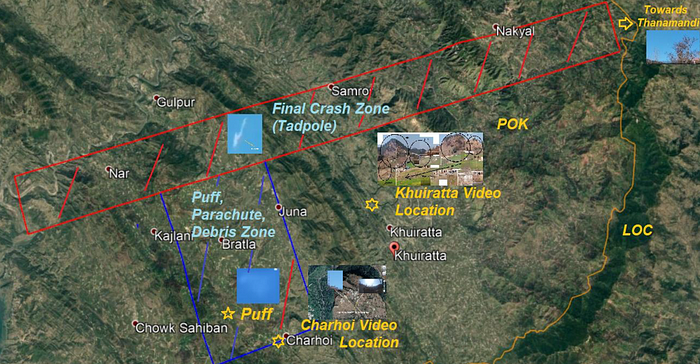
Was it a F-16?
This was the most obvious question for us while we were investigating this crash. That it was a F-16 is is based solely on the IAF’s ELINT signatures, which identified F-16s operating on these radials. In reality, it could have been anything which the PAF flies. But yes, most probably it was a F-16, in addition to the ELINT signature, also verified by the AMRAAM launch against the Abhinandan’s wingman.
Endgame — A bonafide closure to the case!
With this — the investigation and consolidated recreation of the events and the aerial combat which took place in the POK is complete. There will be a ton of questions from like minds, zillions of naysayers haranguing in their ugliest format from across the world, and far more bursting at their seams, laughing at what they would interpret as, skewed logic, a saga of fiction or whatever. Yes, whatever the affiliation, whatever your motivation — but if you are reading this — you want to know the truth or for that matter, find the right loopholes to checkmate the same.
However, the way you perceive your self is what enables, or disables, you. And this has been the cheekiest of them motivations, which has helped me and my collegues — @bennedose @bishwa55900127 @sayareakd @anshumig and @Vakil_Raghu get to the bottom of this affair. Pakistan cannot be allowed to peddle a blatant lie, change the narrative and dismember the ‘truth’ to seek glory for the Pakistan Air Force.
The truth, masked behind ISPR’s ruthless disinformation campaign is that — an Indian Air Force MiG-21 on 27 Feb 19 shot down a PAF fighter jet in Pakistan Occupied Kashmir.
Tragically for the Pakistani nation, with the Pak Army adept at hushing up the deaths of hundreds of its soldiers without as much as batting an eyelid — there is nothing more deceptive than an obvious fact — and somewhere in between this blatant game of lies and deception by the ISPR — is a F-16 tail number and a dedicated PAF pilot — both of whom having served Pakistan to the best of their ability; may now have had their records unceremoniously wiped out from the face of the earth to serve a wider subterfuge of upholding the morale and image of the Pāk Fizāʾiyah, the pantheon of past glory and Pakistan’s best shot at hitting back at India in these times of turmoil. But can any Air Force afford to prosper on a bedrock of lies and deceit, a reputation dented by the controversy, always on the tenterhook of being exposed or for that matter not care at all.
Unfortunately, the Pakistan Air Force with a proud heritage, has done just that!
Never in the past has the PAF had to confront so many quarters, justify and dodge the right questions and disconnect the truth at such a feverish pace. The truth masked by a perpetual lie, far beyond the accepted threshold of chivalry and character of combat aviators over the ages. A convenient lie to serve a few in the Pakistan Army and Air Force, a so called necessary lie which has overwhelmed even the PAF’s finest like Kaiser Tuffail.
There’s an apparent misconception in the Pakistan Air Force that survival of the fittest, means survival of the most aggressive.
Wanton aggression was displayed by the Pakistan Air Force when their topdogs, the F-16s from Sargodha, fired a barrage of AMRAAMs against the IAF Sukhoi formation (Callsign Avenger) across the LoC, aiming to shoot a bunch of them down. What glory was their to be had in getting a kill in a rather sneaky manner — all justified in the name of cold and calculative visage of a modern day air combat. After Balakot, the PAF wanted to prove a point to India, send across a message that the Forces were in balance; risking the highly dynamic threshold of escalation — the hallmark between a bold and stupid decision.
And when challenged by a chip of the old block, a fighter pilot flying an aircraft a generation lower than the PAF’s best, ignoring the thin red line of sound judgement and cheeky recklessness in combat, with that single feat of daring can alter the whole conception of what is possible, displaying aggression at par or more. When confronted with the tip of the sword against their face, the icy cold aggression of the the PAF’s air warriors took a serious hit.
Alpha -1, Wing Commander Abhinadan Varthaman is from a fleet where the ‘Right Stuff’ is still audacity, grit and ingenuity. In the likes of him — there’s still that edge that the Indian Air Force so much believes in; that attitude of leaning into a conflict. No slathering in shaking fits, but a resolute application of will, of force!
Abhinandan, went into the Wolf’s layer across the fence, and threw in a knockout punch in the finest traditions of an Air Warrior. There was no glory for the PAF in shooting his MiG-21 down; if at all there was any glory in this for the PAF, it was to avoid getting any asset shot down!
The PAF miserably failed that day! It has a word for this situation — ‘Tumbleweed”
The PAF may debunk the narrative as convenient, but how does it explain these three moot points —
1. The TADPOLE proves that a man made object on fire, fell over the skies between Kotli and Charohi on 27 Feb 19.
2. There are very clearly — 2 distinct and different crashes noticed in the various videos shot by the residents in the POK on 27 Feb 19.
3. IAF lost ONE MiG-21 over POK on 27 Feb 19. So who lost the other aircraft?
A PAF Shaheen had its last fall that day!
Epilogue
Wing Commander Abhinandan has been awarded with a Vir Chakra for shooting down a PAF F-16
Wing Commander Noman Ali Khan of the Pakistan Air Force has been awarded a similar honour — the Sitara e Jurat
Maj General Asif Ghafoor, the DG ISPR, who with a barrage of his lies exposed in the most worthless manners, is as in the words of a good friend, best seen as a cross between a wannabe Goebbels and the equally infamous and inept ‘Chemical or Comical’ Ali, take your pick; continues his war of deceit, deception and misinformation to keep the loss of the PAF jet, well under wraps, or so he thinks!
________________________________________________________________
Author: Sameer Joshi — Sameer is a retired Indian Air Force Fighter pilot with experience on the MiG-21 and Mirage-2000 jets. Besides being a start-up entrepreneur, Sameer has serious interests in Aerospace & Defence and Military History topics.